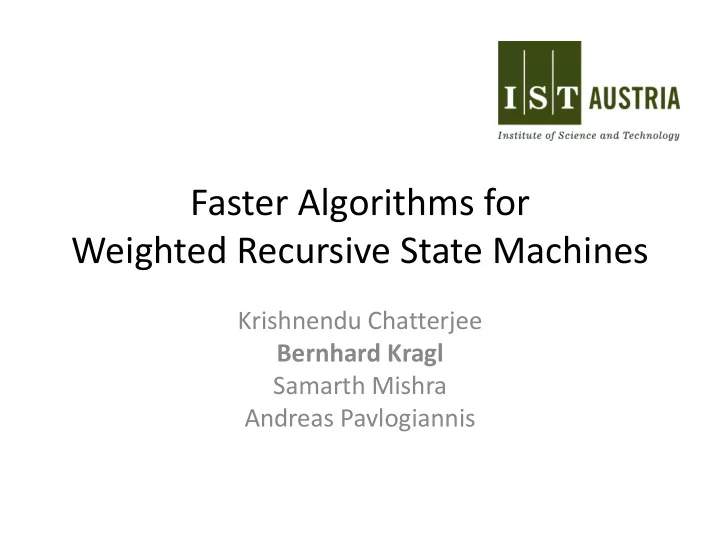

Faster Algorithms for Weighted Recursive State Machines Krishnendu Chatterjee Bernhard Kragl Samarth Mishra Andreas Pavlogiannis
Recursive State Machines (RSMs) ℳ 1 Formal model of recursive computation B Linearly equivalent to pushdown A C systems (PDSs) 𝑐 1 : ℳ 2 Advantages: ℳ 2 • Natural modeling D F • Many parameters G – Number of modules 𝑔 𝑐 2 : ℳ E 1 – Entry bound 𝜄 𝑓 = max 𝐹𝑜 𝑗 𝑗 – Exit bound 𝜄 𝑦 = max |𝐹𝑦 𝑗 | 𝑗 𝐵, 𝜁 ⇒ 𝐹, 𝑐 1 ⇒ 𝐵, 𝑐 2 𝑐 1 – 𝜄 = max min( 𝐹𝑜 𝑗 , |𝐹𝑦 𝑗 |) ⇒ 𝐶, 𝑐 2 𝑐 1 ⇒ 𝑐 2 , 𝐷 , 𝑐 1 𝑗 – … ⇒ 〈 𝑐 1 , 𝐻 , 𝜁〉 2
RSMs over Semirings Label RSM transitions with weights from idempotent semiring 〈𝑋,⊕,⊗, 0,1〉 weight of computation: ⊗ weight of computation set: ⊕ 𝑿 ⊕ ⊗ 0 1 ∨ ∧ ⊥ ⊤ Reachability ℝ + ∪ {∞} + ∞ Shortest path min 0 [0,1] ⋅ Most probable path max 0 1 𝑒 2 𝐸 ⊓ ∘ 𝜇𝑦. ⊤ 𝜇𝑦. 𝑦 2 𝐸 IFDS Canonical partial order Monotonicity 𝑏 ≤ 𝑐 ⇔ 𝑏 ⊕ 𝑐 = 𝑏 𝑏 ≤ 𝑐 ⇒ 𝑏 ⊗ 𝑑 ≤ 𝑐 ⊗ 𝑑 Finite-height: 𝐼 ∈ ℕ longest descending chain in ≤ 3
Distance Problems Given a set of initial configurations 𝑇 • Configuration distance 𝑒 𝑇, 𝑣, 𝑐 1 ⋯ b 𝑜 • Superconfiguration distance 𝑒 𝑇, 𝑣, ℳ 1 ⋯ ℳ 𝑜 • Node distance 𝑒 𝑇, 𝑣 4
Our Solution 1. Configuration automata Representation structures for sets of RSM configurations [BEM’97] Initial automaton 𝐷 , s.t. ℒ 𝐷 = 𝑇 2. Dynamic programming algorithm Compute 𝐷 ∗ , representing reachable configurations and distances Key: Entry-to- Exit summaries [ABEGRY’05] 3. Distance extraction algorithms Query configuration/superconfiguration/node distances from 𝐷 ∗ 5
Configuration Automata run assembles states correspond a stack to RSM nodes 𝑣 𝜁|𝑤 1 ⋯ 𝑐|𝑤 2 𝑓 𝑓′ 𝑟 𝜁|𝑤 4 𝑣′ 〈𝑣, 𝑐 ⋯ 〉 is an accepted configuration Weight of configuration is ⨁ over all accepting runs 6
Relaxation Steps 𝑤 2 𝑣′ Exit transition: 𝑣 𝑦 Internal transition: 𝑣 𝜁|𝑤 1 𝜁|𝑤 𝑐|𝑤 2 𝑣 𝑓 𝑣 𝑓 𝑓′ 𝜁| … ⨁(𝑤 1 ⊗ v 2 ) 𝜁 … ⊕ (𝑤 2 ⊗ 𝑡𝑣𝑛 𝑓, 𝑦 𝑡𝑣𝑛 𝑓, 𝑦 𝑣′ 〈𝑐, 𝑦〉 : = ⋯ ⊕ 𝑤 𝑤 2 𝑐, 𝑓 ′ Using summary: 𝑡𝑣𝑛 𝑓 ′ , 𝑦 Call transition: 𝑣 𝜁|𝑤 1 𝑐|𝑤 𝑣 𝑓 𝑓′ 𝑓 𝜁| … ⊕ 𝑤 ⊗ 𝑡𝑣𝑛 𝑓 ′ , 𝑦 𝑐| … ⊕ (𝑤 1 ⊗ 𝑤 2 ) 𝑓′ 〈𝑐, 𝑦〉 7
Reachability Example F ℳ Summaries: 1 𝜁 𝐵 ⇝ 𝐷 B 𝐹 ⇝ 𝐻 𝐸 ⇝ 𝐻 A C D 𝑐 1 : ℳ 2 𝑐 1 𝜁 𝜁 〈𝑐 1 , 𝐻〉 A B ℳ 2 𝑐 1 𝑐 2 D F G E 𝑐 2 : ℳ E 1 𝜁 〈𝑐 2 , 𝐷〉 8
Correctness and Complexity For every configuration 𝑑 : 𝑒 ℒ 𝐷 , 𝑑 = 𝐷 ∗ (𝑑) 𝐷 ∗ is constructed in time 𝒫 𝐼 ⋅ ℛ ⋅ 𝜄 𝑓 + 𝜄 𝑓 ⋅ 𝜄 𝑦 ⋅ 𝐷𝑏𝑚𝑚 Compared to PDS algorithm 𝒫 𝐼 ⋅ ℛ ⋅ 𝜄 𝑓 ⋅ 𝜄 𝑦 ⋅ 𝑔 ℛ ⋅𝑔 Factor 𝜄𝑦 + 𝐷𝑏𝑚𝑚 improvement |ℛ| 9
Empirical Evaluation RSM-based algorithm vs. PDS-based algorithm Our tool jMoped 1. Scaling on artificial examples 2. Interprocedural program analysis problems 10
A Family of Dense RSMs ℛ 3 𝜄 𝑦 + 𝐷𝑏𝑚𝑚 = 𝑜 2 ⋅ 1 ℛ ⋅ 𝑔 = 𝒐 |ℛ| 𝑜 2 𝑜 +𝑜 11
Boolean Programs from SLAM/SDV Absolute runtime (seconds) Relative speedup 12
Our Solution 1. Configuration automata Representation structures for sets of RSM configurations [BEM’97] Initial automaton 𝐷 , s.t. ℒ 𝐷 = 𝑇 2. Dynamic programming algorithm Compute 𝐷 ∗ , representing reachable configurations and distances Key: Entry-to- Exit summaries [ABEGRY’05] 3. Distance extraction algorithms Query configuration/superconfiguration/node distances from 𝐷 ∗ 13
Distance Extraction • Configuration distance for 〈𝑣, 𝑐 1 ⋯ 𝑐 𝑜 〉 𝑓 0 𝑡 𝑓 1 𝑡 𝑓 𝑜 𝑡 𝑐 𝑜 𝜁 𝑐 1 ⋯ u 2 Dynamic programming: 𝒫 𝑜 ⋅ 𝜄 𝑓 • Superconfiguration distance for 〈𝑣, ℳ 1 ⋯ ℳ 𝑜 〉 𝑐 𝑓′ with 𝑓 ℳ 𝑓′ where ℳ is module of 𝑓′ Replace 𝑓 • Node distance Traditional single-source distance problem 14
Distances over Small Semirings 𝑋 𝜄 𝑓 vector 𝑋 𝜄 𝑓 ×𝜄 𝑓 matrix 𝜁 𝑓 𝐷 ∗ transitions labeled 𝑐 𝑗 𝐷 ∗ transitions 𝑣 𝑈 1 𝜄 𝑓 ⋅ 𝐵 𝑣 ⋅ 𝐵 𝑐 1 ⋯ 𝐵 𝑐 𝑜 ⋅ 1 𝜄 𝑓 • Constant size semiring (Mailman’s speedup) 2 𝜄 𝑓 𝒫 𝑜 ⋅ log 𝜄 𝑓 Size 𝑋 semiring (William’s speedup) • 2 𝜄𝑓 for 𝜁 > 0 , 𝒫 𝑜 ⋅ (some preprocessing) 𝜁2log2 𝜄𝑓 • Binary semiring (Four-Russians speedup) 𝑜 𝒫 ℛ ⋅ 𝜄 𝑓 ⋅ log 𝑜 15
Summary • Faster interprocedural analysis (RSM > PDS) • Configuration automata Saturation algorithm (summaries) Distance extraction • More in the paper – Further distance extraction speedups – Implications for context-bounded analysis (concurrency) 16
17
18
Recommend
More recommend